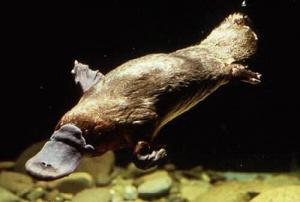 Platypus: an egg-laying mammal
Platypus: an egg-laying mammal Unlike the authors of Explore Evolution, many elementary school students are well aware that there are mammals which lay eggs, and that there are snakes which have placentas. Scattered among errors so elementary that grade-school students could correct them, this chapter is laced with statements which requiring a level of knowledge far beyond even typical college biology students. Questions are posed to students which cannot be answered without much more background than the book provides, or than the average high school teacher is trained to provide. The book does not offer such resources, nor suggest ways that students could explore those questions through independent inquiry.
The flaws in the chapter go much deeper than such errors and inconsistencies. The practice of science is misrepresented, and common misconceptions about evolution are actively promoted. Far from encouraging scientific inquiry, this chapter blocks and discourages genuine inquiry. Given that the book parrots creationist misrepresentations of biology, then shuts off inquiry into scientific answers to those questions, it is easy to see that the book's aim is to instill exactly those creationist errors.
p. 130: "any transition from a three-chambered heart to a four-chambered heart requires a series of coordinated changes."
This is a recapitulation of the fallacious "irreducible complexity" argument of intelligent design creationism. Evolutionary and developmental biologists have clear understandings of how morphological structures can and do evolve in parallel.
p. 137
: "can there even be a transition between a single-opening and a dual-opening system [of lungs]?"Scientists have good evidence explaining the evolution of bird lungs with two openings from reptilian lungs with only one opening. None of that evidence is offered.
p. 137: "the ancestors of birds almost certainly had a diaphragm breathing system"
This claim is advanced on the basis of a controversial and widely-criticized paper from 1997, and even that paper does not support this claim. No discussion is offered of the subsequent research offering further evidence against this idea.
p. 129: "the superficial resemblance between skeletons [of early mammals and early reptiles]"
The fossil record of early mammals is one of the most continuous records available to paleontologists, and the chain of similarities is hardly superficial.
p. 130: "Transforming a reptile into a mammal requires the development of completely new organs like the placenta and mammary glands"
Placentas have evolved dozens of different times within modern reptiles, and mammary glands are highly modified sweat glands, so it is wrong to claim either of these are "completely new organs." More significantly, mammals are not "transformed" from reptiles: they share a common ancestor, but neither descended from the other.
p. 129: "Most reptiles lay eggs, while mammals carry fertilized eggs internally in a placenta and bear live young."
There are mammals which lay eggs, and many other mammals which have live birth but lack a placenta. No discussion is offered of the placentas found in several groups of reptiles.
p. 138: "all we can say for sure is that the internal organs of living reptiles, living birds, and living mammals are very different from one another"
We can do far more than just say that different things are different. The patterns of differences and similarities between living species and between preserved remains of extinct species gives us insight into the evolutionary processes driving those differences. Explore Evolution fails to provide students with the background to allow them to explore this fascinating field: evolutionary biology.
Major Flaws:
Hearts: In discussing the evolution of the four-chambered mammalian heart from the three-chambered reptilian heart, Explore Evolution omits any reference to existing scientific models of that evolutionary path, and makes gross misstatements about the anatomy of hearts in living animals.
Lungs: In discussing the evolution of bird-like lungs from reptilian ancestors, the authors make inaccurate claims about the lungs of bird ancestors, and misrepresent the biology of modern birds and crocodilians. There is no discussion of existing research on the evolution of bird lungs, research answers the very questions posed by Explore Evolution.
Transitional Forms: Explore Evolution states that all mammals give birth to live young and possess a placenta, while all reptiles lay eggs and lack a placenta. In fact, many groups of reptiles have evolved a placenta, and there are mammals which lack a placenta and lay eggs. Each of those counterexamples represents a living transitional form, and it is possible to study the evolution of placentas, lactation and egg-laying using both modern species and fossils. Explore Evolution obfuscates the truth and confuses students with creationist falsehoods.
